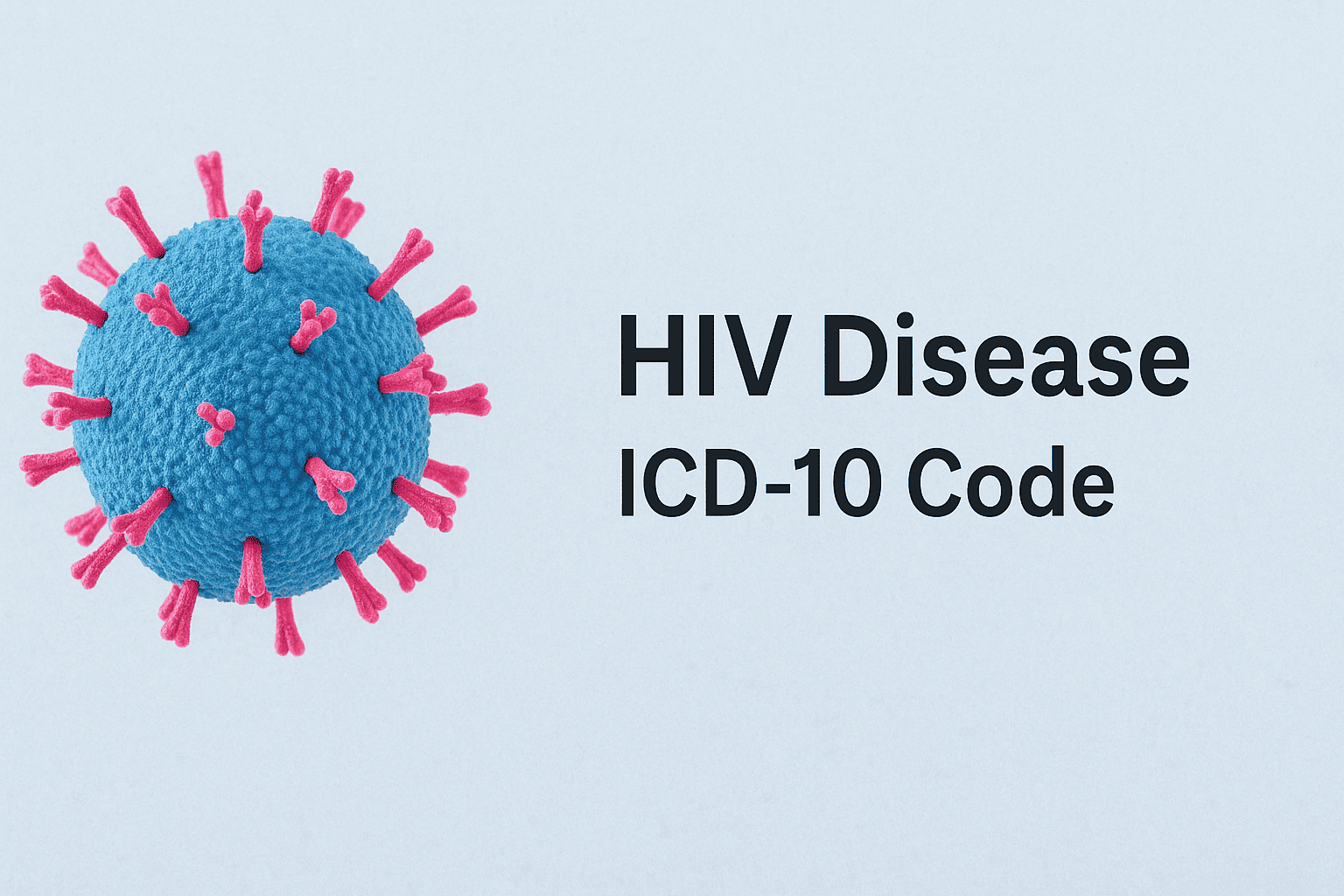Updated on: July 23, 2025
Human Immunodeficiency Virus (HIV) disease is a chronic viral infection that progressively weakens the immune system, making individuals more susceptible to opportunistic infections and certain cancers. ICD-10 code B20 is used when HIV infection has progressed to AIDS or when the patient is symptomatic.
When to Use ICD-10 Code B20
Use B20 when:
-
The patient has confirmed HIV infection AND
-
There are documented symptoms or HIV-related illnesses
Examples of HIV-related conditions:
-
Candidiasis
-
Kaposi’s sarcoma
-
Pneumocystis jirovecii pneumonia (PCP)
-
HIV-related encephalopathy
-
Chronic diarrhea due to HIV
🔍 Important: Never assign B20 based solely on positive HIV test results. Use it only when symptoms or HIV-related conditions are present.
ICD-10 Codes for Asymptomatic and Screening
| Condition | Use This Code |
|---|---|
| Asymptomatic HIV infection | Z21 |
| HIV testing / screening | Z11.4 |
| Inconclusive HIV serology | R75 |
Tip: Z21 and R75 are not interchangeable with B20. Use B20 only for symptomatic or progressed HIV disease.
Clinical Documentation Tips for B20
To code HIV disease accurately under B20, documentation should clearly state:
-
HIV diagnosis is confirmed
-
Symptoms or AIDS-defining illnesses are present
-
Duration and severity of opportunistic infections
-
Response to antiretroviral therapy
-
Co-infections (e.g., TB, Hepatitis B/C)
Example of Effective Documentation:
“Patient is HIV positive with a 3-year history. Presents with persistent oral thrush and weight loss. CD4 count <200. Started on antiretroviral therapy and antifungal agents. Assessment: HIV disease with secondary candidiasis.”
Coding HIV-Related Conditions with B20
When coding HIV-related illnesses, always sequence B20 first, followed by the specific secondary diagnosis.
Example ICD-10 Combinations:
| Primary Code | Description | Secondary Code | Condition |
|---|---|---|---|
| B20 | HIV disease | B37.0 | Oral candidiasis |
| B20 | HIV disease | C46.0 | Kaposi’s sarcoma |
| B20 | HIV disease | J16.8 | Pneumocystis pneumonia |
HIV Diagnosis Workflow and Testing
Clinical workflow for HIV diagnosis includes:
-
Initial screening test (Z11.4)
-
Confirmatory testing (e.g., Western blot, PCR)
-
Viral load and CD4 count assessments
-
Opportunistic infection workup
-
Documentation of ART status (current vs non-compliant)
Accurate record-keeping of these clinical components is essential to justify B20 billing and ongoing care.
Role of AI Medical Scribes in HIV Care Documentation
With complex documentation needs like HIV, AI-powered scribing tools such as DocScrib streamline:
-
Auto-capture of HIV-related symptoms and comorbidities
-
ICD-10 recommendations in real time
-
Ensuring proper sequencing (B20 first, then secondary codes)
-
Avoiding under-documentation that could delay reimbursement
👉 Explore DocScrib’s AI medical scribe solution
Reimbursement and Coding Compliance
B20 is a high-complexity diagnosis and often supports higher-level E/M codes and specialist visits. To ensure compliance:
-
Use specific secondary diagnosis codes
-
Avoid overuse of B20 in asymptomatic patients
-
Document treatment and comorbidity management
💡 HIV-related documentation errors often trigger payer audits. Using AI tools ensures billing precision and minimizes denial rates.
Frequently Asked Questions
Can I use B20 if the patient is only HIV-positive with no symptoms?
No. Use Z21 for asymptomatic HIV-positive patients.
What’s the difference between B20 and R75?
B20 is for confirmed, symptomatic HIV. R75 is used for inconclusive or indeterminate serology results awaiting further testing.
Should I list opportunistic infections separately?
Yes. Always code B20 first, then specify each secondary infection or condition.
Conclusion
ICD-10 Code B20 is reserved for symptomatic HIV disease and AIDS-defining illnesses. Accurate documentation and sequencing are crucial to ensure correct billing, optimize care, and prevent claim denials. With the help of AI-powered scribes like DocScrib, clinicians can simplify HIV documentation, reduce administrative burden, and focus more on patient care.
Ready to automate HIV documentation workflows with zero errors?
👉 Book your free demo with DocScrib now
